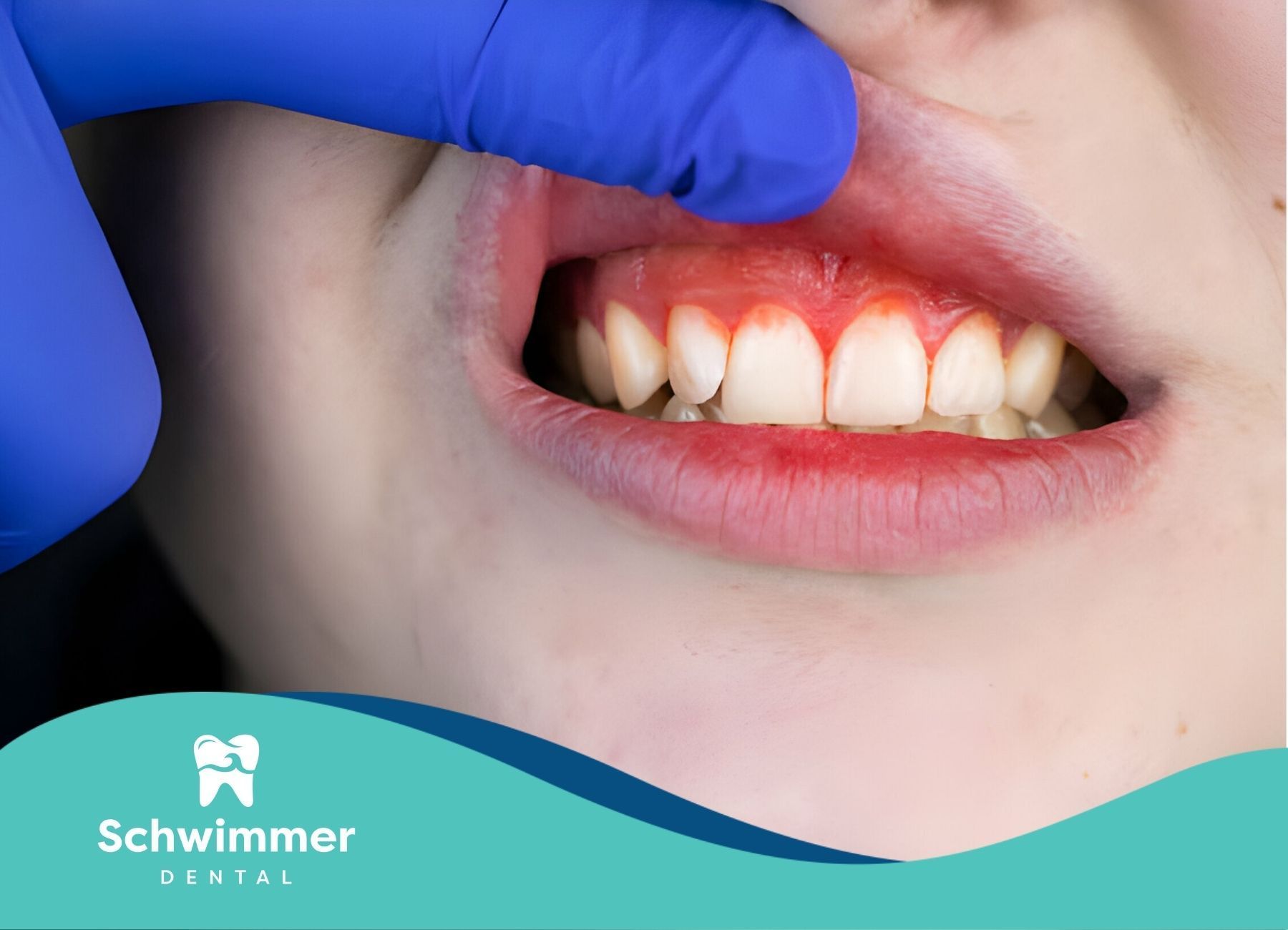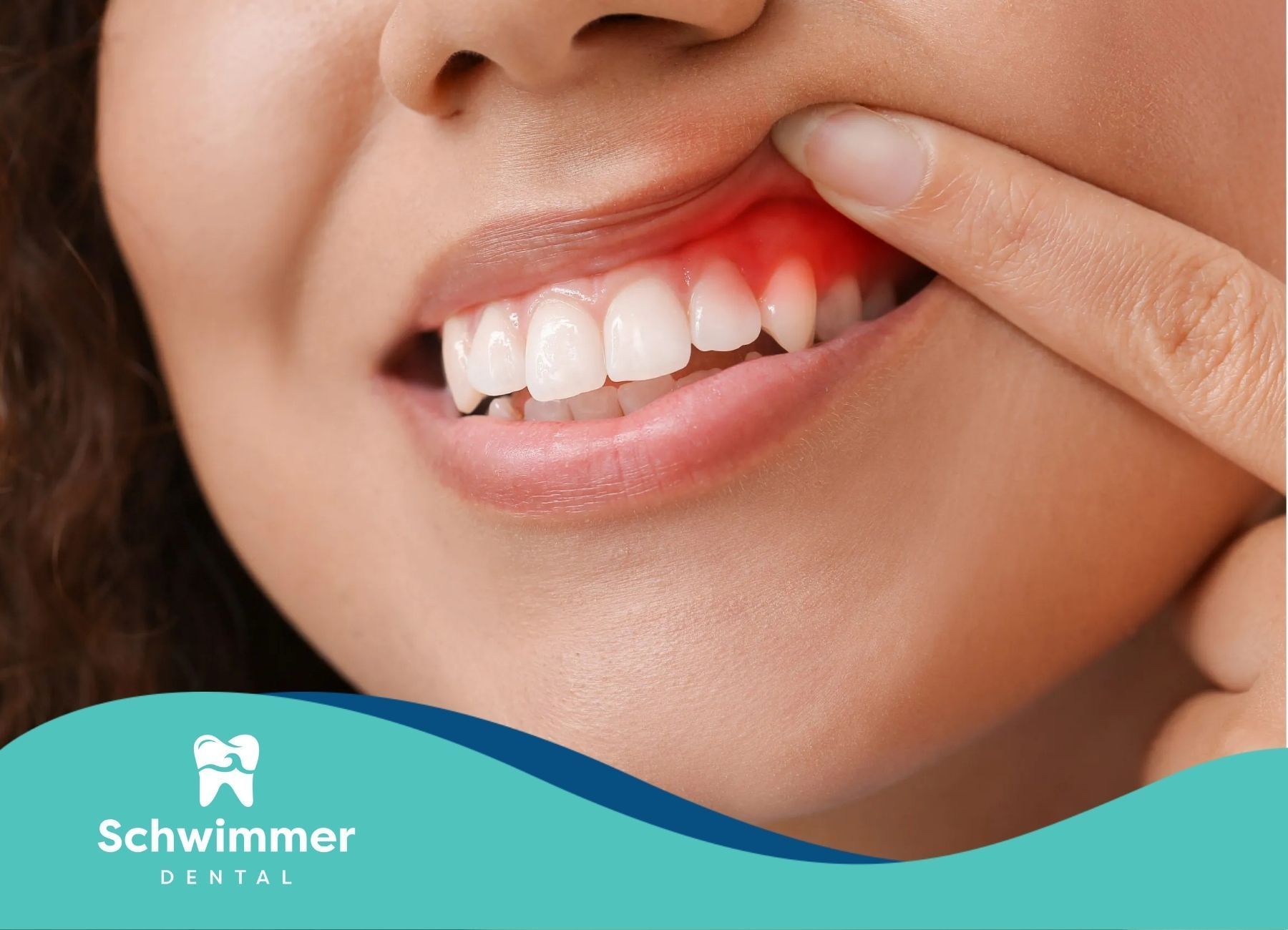Have an appointment? Complete the Intake Form
How to Prevent and Treat Gum Recession
Key Highlights
- Gum recession is a common dental concern where the gum tissue pulls back, exposing the tooth roots.
- It commonly stems from factors like periodontal disease, aggressive brushing habits, and tobacco use.
- If you experience symptoms like tooth sensitivity, exposed roots, or a receding gum line, consult a dental professional.
- Treatment options vary from deep cleanings and antibiotics to surgical procedures like gum grafting.
- Maintaining optimal oral hygiene through regular brushing, flossing, and dental checkups is crucial for preventing further gum recession.
Have you noticed your teeth appearing longer than usual or felt increased sensitivity when eating or drinking? These could be signs of gum recession, a common dental issue where gum tissue pulls back, exposing the roots of your teeth. While it may start subtly, untreated gum recession can lead to discomfort, tooth decay, and even tooth loss.
The good news is that gum recession is treatable, with solutions ranging from professional cleanings to advanced surgical procedures. Let's explore the causes, symptoms, and best treatment options for gum recession.
Understanding Gum Recession
In simple terms, gum recession process of your gum tissue pulling away from your teeth. Imagine the gum line as the protective border safeguarding the roots of your teeth. When this border recedes, it exposes the underlying tooth structure, making your teeth more vulnerable.
This vulnerability arises because the exposed roots lack the enamel that shields the visible parts of your teeth. As a result, receding gums can lead to heightened sensitivity, discomfort while eating, and an increased risk of tooth decay. It's often a gradual process that might go unnoticed until the recession becomes more prominent.
The Causes Behind Gum Recession
Wondering what could be causing your gums to recede? A leading culprit is periodontal disease, commonly known as gum disease. This infection, fueled by plaque buildup, wreaks havoc on your gums and the bones supporting your teeth. The inflammatory response triggered by harmful bacteria can cause gum tissues to recede.
But gum disease isn't the only factor at play. Aggressive toothbrushing habits can also contribute to gum recession. While it's essential to maintain a clean mouth, brushing too hard or using a hard-bristled toothbrush can wear down gum tissue over time.
Another common offender is the use of tobacco products. Smoking and chewing tobacco introduce harmful chemicals into your mouth, hindering blood flow to the gums and making them more susceptible to recession.
Identifying the Signs of Gum Recession
Early detection is key when it comes to gum recession. By recognizing the signs early on, you can take proactive steps to manage the condition effectively. One of the most evident signs is tooth sensitivity, particularly to cold or hot temperatures. If you find yourself wincing while enjoying your favorite iced beverage or warm soup, it might be time to check your gums.
Another telltale sign is noticing that your teeth appear longer than before or feeling a notch or groove near the gum line. This often indicates that the roots of your teeth are becoming exposed as the gums recede. Additionally, persistent bad breath or a bad taste in your mouth can also signal gum issues, including recession.
Keep a watchful eye out for any changes in your gums, such as redness, swelling, or bleeding while brushing or flossing. If you experience any of these signs, scheduling a visit with your dentist is crucial for a thorough dental examination.
Professional Treatments for Gum Recession
Dealing with receding gums? Rest assured, your dentist has a range of treatments to address this issue. The approach generally depends on the severity of the recession and its underlying cause. For less severe cases, a professional deep cleaning might be the solution.
However, if the recession is more significant or accompanied by bone loss, your dentist might recommend surgical procedures to restore the gum line and protect your teeth. Let's discuss the various treatment options in more detail.
Scaling and Root Planing, Explained
You've probably heard of a "deep cleaning" at the dentist's office, but what does it involve? In the context of gum recession, deep cleaning consists of two main procedures: scaling and root planing.
Tooth scaling targets the removal of plaque and tartar deposits from your teeth, both above and below the gum line. Imagine it as a thorough cleaning that goes beyond what your regular toothbrush can achieve. This step helps eliminate the harmful bacteria contributing to gum inflammation and recession.
Root planing, on the other hand, focuses on smoothing the root surfaces of your teeth. This smoothing process discourages further plaque and bacteria buildup, allowing your gums to heal and reattach to the teeth more effectively.
The Role of Gum Graft Surgery
Gum graft surgery is a common procedure used to address more advanced cases of gum recession. This minimally invasive procedure aims to restore lost gum tissue and improve both the aesthetics and health of your smile. During the procedure, a small piece of tissue, called a gum graft, is taken from another area of your mouth, typically the palate.
Why is a gum graft necessary? It provides a fresh layer of connective tissue that covers the exposed tooth roots, shielding them from further damage and sensitivity. This graft also helps reinforce the gum line, preventing future recession and enhancing the overall appearance of your teeth.
| Type of Gum Grafts | Description |
|---|---|
| Connective Tissue Graft | The most common type; uses tissue from the roof of the mouth to cover exposed roots. |
| Free Gingival Graft | Uses tissue directly from the palate to thicken the gums. |
| Pedicle Graft | Takes tissue from the gum near the receding area and pulls it over the exposed root. |
Advances in Pinhole Surgical Technique
In recent years, advancements in dentistry have introduced innovative procedures like the Pinhole Surgical Technique (PST) as an alternative to traditional gum grafting. This minimally invasive technique offers several benefits, notably a shorter recovery time.
As the name suggests, PST involves creating a small pinhole-sized incision in the gum tissue above the receding area. Through this tiny incision, specialized instruments are used to gently loosen the existing gum tissue and reposition it to cover the exposed roots. Since it doesn't require sutures, patients typically experience less post-operative discomfort and a faster healing process.
This technique has gained popularity due to its ability to address multiple teeth in a single session, making it a convenient option for those with widespread gum recession. If you're considering gum surgery, ask your dentist about the suitability of the Pinhole Surgical Technique for your specific needs.
At-Home Care for Gum Recession
While professional treatments are essential for addressing gum recession, your at-home care routine plays a vital role in supporting gum health and preventing further deterioration. Think of it as a partnership between you and your dentist to ensure long-lasting results.
Alongside following your dentist's recommendations diligently, incorporating simple yet effective oral hygiene practices into your daily life can significantly impact your gum health. Let's explore some practical at-home care tips for gum recession.
Effective Oral Hygiene Practices
Maintaining excellent oral hygiene is the cornerstone of healthy gums and teeth, especially if you're dealing with gum recession. But proper oral hygiene goes beyond just brushing your teeth. It requires a holistic approach to ensure your mouth stays healthy and vibrant.
Firstly, make sure you're using a soft-bristled toothbrush and brushing gently, using circular motions to avoid further irritating your gums. Brushing twice a day, in the morning and before bed, helps remove plaque buildup effectively. Remember to replace your toothbrush every three to four months, or sooner if the bristles become frayed.
Additionally, don't neglect the importance of flossing daily! Flossing helps remove food particles and plaque from between your teeth, where your toothbrush can't reach. Remember, regular dental checkups are also an essential part of your oral hygiene routine. Visiting your dentist every six months for a professional cleaning and checkup allows for early detection and prompt treatment of any potential problems.
The Impact of Diet on Gum Health
Believe it or not, your diet plays a crucial role in your overall health, including the well-being of your gums! Just like certain foods nourish your body, there are also foods that can either harm or promote gum health. So, making mindful dietary choices can go a long way in preventing gum recession and other dental issues.
Firstly, limit your intake of sugary drinks and processed foods, as they tend to create an acidic environment in your mouth that erodes tooth enamel and weakens gums, making them susceptible to recession.
On the other hand, incorporating plenty of fruits, vegetables, and whole grains into your diet can work wonders for your gum health. These foods are rich in essential vitamins and minerals that strengthen your gums and support their natural defenses against harmful bacteria.
Conclusion
In conclusion, preserving your gum health and addressing gum recession promptly is crucial for overall oral well-being. Understanding the causes, recognizing the signs, and exploring professional treatments can help prevent further complications. Incorporating effective oral hygiene practices and a tooth-friendly diet alongside professional care can aid in maintaining gum health. Remember, early intervention is key to successful treatment outcomes.
At Schwimmer Dental, we offer advanced treatments tailored to your unique needs, ensuring your smile stays strong and beautiful. Don’t wait—schedule a consultation with Schwimmer Dental to explore how we can restore your gums and give you the confidence to smile brightly again!
FAQs
Can receding gums grow back naturally?
Unfortunately, gum tissue doesn't regenerate naturally. Once the gum line recedes, it won't grow back on its own. However, treatments like gum grafting can help restore the gum line by using regenerative materials.
How can I prevent further gum recession?
Preventing further gum recession involves adopting healthy habits that promote good oral hygiene. Brushing gently, flossing daily, and visiting your dentist regularly are essential protective measures against plaque buildup and gum disease.
Is gum graft surgery painful?
Gum graft surgery is typically performed under local anesthesia, ensuring patient comfort throughout the procedure. Pain management techniques and proper post-operative care help minimize discomfort during recovery.
Need Assistance? We’re Here to Help
We are dedicated to enhancing your dental health and well-being.
We provide personalized dental care solutions for a confident, healthy smile.
Contact us today for Professional Dental Care.

Our caring staff will help you feel relaxed and comfortable in our state of the art office. We respect your time and pledge to deliver prompt service, backed by the latest knowledge, techniques, and technology.
Email: Office@schwimmerdental.com
Tel: (848) 294-2385
Fax: (732) 899-3347
Address: 1115 Arnold Ave,
Point Pleasant, NJ, 08742
Schwimmer Dental – Website by CWS


